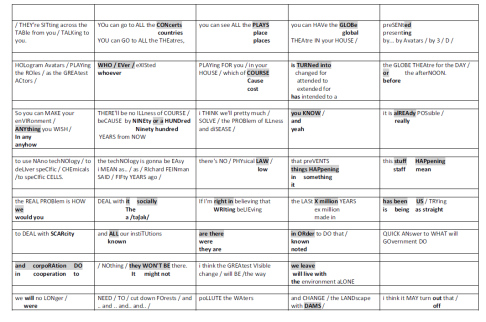A while ago, when we started working on listening decoding skills with one of my groups, I asked them to transcribe this video starting at 00:50:
They are an upper-intermediate group of eight secondary students who have had a lot of listening practice (including practice with authentic materials). As it turned out, it had taken them between 30 minutes and 2 hours to transcribe this 3-minute video clip. I then compiled their versions and we tried to analyze the source of each problem and put the problems on this map.
What I was trying to achieve was enable them to analyze why they fail to catch something when they work on decoding individually so that hopefully they would see some patterns. Here’s the compilation. I find it very interesting: I almost feel like I get into their heads and hear with their ears as I’m trying to hear how each of their versions could be heard. One of the courses I’m doing this term is a listening comprehension course, so I’ll try to use this as a resource to train my future students to analyze listening difficulties.










One of the things that I’ve discovered so far… I use “tags”, for instance a beginner is to focus only on WHO did what (grabbing pronouns and verbs). Then we try to make some sense out of that and then we listen one more time, but this time we’re aiming at details. Then we put it all together in our piece.
That’s one way around…
Another thing I’ve noticed is that translation from English into Russian fades away with the growing comfort and speed of understanding that phrase by applying familiarity concept.
Hello– thank you for such great ideas about approaching listening. I’m going to try this with a class this week.
A quick question– the link to the video isn’t working anymore. Is there any chance that you have another link?
Hi Anna,
It’s the video from this page: https://www.bbc.com/news/av/magazine-24331106/what-will-life-be-like-in-the-year-2100-james-burke-predicts
Thank you so much Olya, I really appreciate it 🙂